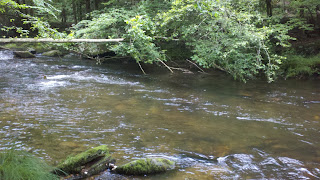I had an interesting conversation about the differences between people that catch fish on a regular basis and those that don't. It all seemed to boil down to the ability of the person to look at the water, find fish, and then give them the right bait at the right time. I know that sounds stupid, but there is a level of knowledge and skill involved in finding fish and presenting the correct bait in the correct manner.
Finding fish is a skill in itself. Some folks can just look at the water and can tell you if there are fish there. On the other hand, I have seen people stand in dead water (water with no fish) for hours or wade right out into the middle of prime fishing areas because they don't know what they are looking for. To find fish you need to understand some of the basic needs of fish such as food and shelter and how fish utilize the water and the rocks for those things. You also need to understand how fish feed and where they are feeding.
For example, the area in the picture above is a great place to find fish. It has a lot of shelter for fish in the form of overhead foliage, a large rock in the stream that breaks up the current, and a deep pool of water with large rocks where a fish can hide/hold. An area like this also gives them a break from the current so they don't expend more energy than they can get from feeding. An area like this is also perfect for fish to feed. Food will be washed into the pool by the main current where it takes less effort for them to locate and capture the food.
To present the correct bait at the correct time it's important to understand how they feed. Fish generally sit in a safe place and face upstream. The sit and wait until they see something that they will eat and then they either move to the food or let the food come to them. Either way they generally eat and then make a small circle and settle back down into their spot and wait for something else to float down their way. Also, food may be at one specific level in the stream. It may be deep under the water, just under the surface, or floating on the surface. Most of the time fish feed below the surface of the water. I have read that trout feed 90% of the time below the surface. If you see a fish breaking the surface but not leaving bubbles it is most likely that the food is just below the surface. If you see a fish breaking the surface and leaving bubbles it is likely that the fish is feeding on something on top of the water.
So to catch a fish you have to put all of that information to use. One of the best techniques that I have learned is to select 100 or 200 yards of stream or river, observe and plan how I am going to fish each section, fish from downstream to upstream, and not get into the water if I don't have to. This allows me to approach each possible holding area with an idea of how to fish it and makes it harder for the fish to see or detect me. Since they face upstream they generally have a blind spot to their rear. Not getting in the water makes it harder for them to detect me also. They might not be able to see me, but they might be able to "hear" if I splash around too much. If the river or stream is wide I also split it in half and fish up one side and then the other side. I also start fishing on the near side of likely feeding and holding areas and work my way to the far side. This prevents scaring fish holding on the other side of the pool with a cast or having line pass over them. So in the pool in the picture above I would start casting into the tail of the pool at the right of the picture right where the seam is created by the water moving fast around the rock and slow in the pool and work my way to the left. I would also keep as much line off of the water as possible by keeping my rod held high. I would then cast to the other side of the pool and work my way up to the rock alternating casts to the near side seam and then the far side seam. I would also use a rig that would allow me to fish under the water (to a depth that would make the bait bounce off the bottom) and on top of the water. Maybe a larger floating fly with a small dropper fly and change to one or the other if one of the two was catching all the fish.
So the key to catching fish is to learn where fish like to be, how they like to eat, what they like to eat, and then utilize the proper tactics to present them with something that they want to eat without scaring them from their holding areas. If you can do that you will catch fish.

No comments:
Post a Comment